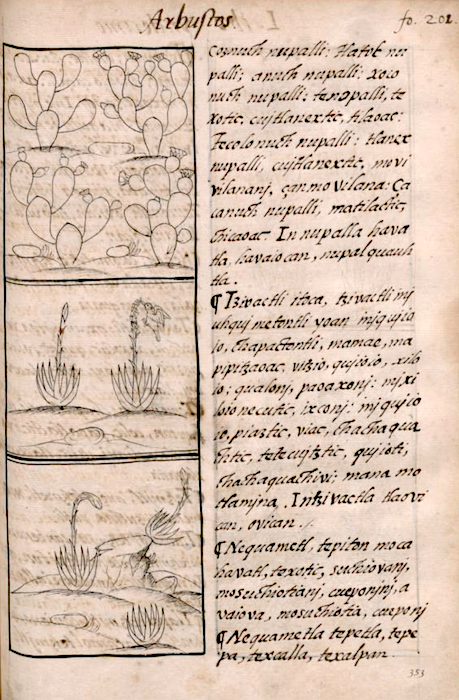tzihuactli (FCbk11f218r)
These are logograms for a pair of tzihuactli (a type of small maguey plant with a cylindrical stalk). The image is found on folio 218 recto of the Florentine Codex, Book 11, “Natural Things,” in the “Twelfth Paragraph, which telleth of the nature of trees.” The illustration, with its black-outlined elements, shows the plant in two stages of development, the one on the left having put up a stem with a bud on its top, and the one on the right in bloom with a left-facing hummingbird enjoying its nectar. Both plants are growing out of small mounds of earth in a naturalistic, uneven landscape. The pair are included here as examples of iconography related to hieroglyphs found elsewhere in this Visual Lexicon incorporating and depicting tzihuactli in various ways (see below).
A metaphorical use of tzihuactli is found in the huehuetlatolli (“elders’ wisdom; words of the elders”) compiled under the leadership of Fray Andrés de Olmos. In the published version’s glossary, an editor’s note tells us that “in the original Nahuatl, tzihuactli, teteihuitl, is a diphrasism that refers to two objects [used in] sacrificial rites.”
Robert Haskett
According to the text of Book 11, the tzihuactli “is like a small maguey…. It has leaves, slender leaves. I has spines, it has stems, it has a silk…. It forms a stem, becomes rough, extends, shoots out. The tziuactli patch is a place of danger, a difficult place” (translation by Anderson and Dibble [1950-1982], 218). In Book 10, “The People,” Chapter 29, “Which Telleth of the Various kinds of People,” the text discusses eating habits of the Chichimeca, stating that their food includes “nopal, tuna, roots of the cimatl herb, tziuactli cactus,” etc. (Anderson and Dibble, [1950-1982], 174). The plant is also mentioned in Book 3 (“How the Gods had their Beginning”), “Appendix, Which Telleth of the Souls of Those who Died and of Still Other Services [Rendered] the Rulers.” in Chapter 3, “in which are recorded those who went to heaven,” the text describes the afterlife in the “home of the sun” of warriors who died in battle or in various kinds of sacrificial rites. For the first four years they “dwelt where was only a place like a plain,” a place where there were “the magueys, the thorny shrubs, and clumps of mesquites.” According to footnote 1 on this page, Eduard Seler identified the “thorny shrubs” as tzihuactli, a plant “found in the Chichimec highlands“ (Anderson and Dibble [1950-1982], 47). Finally, a metaphorical use of tzihuactli is found in the huehuetlatolli (“elders’ wisdom; words of the elders”) compiled under the leadership of Fray Andrés de Olmos. In the published version’s glossary, an editor’s note tells us that “in the original Nahuatl, tzihuactli, teteihuitl, is a diphrasism that refers to two objects [used in] sacrificial rites” (356). The pairing appears in paragraph 70 of the Nahuatl text, where a young man responds to a father giving him advice about marriage (Olmos [2013]). Thus tzihuactli is a plant with edible properties associated with the Chichimec highlands as well as the place where deceased warriors resided for a time that also had metaphoric and portentous qualities, perhaps related to its use in blood offerings to the sacred forces of the cosmos.
Robert Haskett
Tzivactli
Tzihuactli
Robert Haskett
c. 1570
Robert Haskett
magueys, magueyes, agaves, tallos, spines, espinas, scapes, stalks, blossoms, flowers, tzivactli, tziuactli, xiuhpohualli, año, turquesa, xihuitl

tzihuac(tli), small agave plant with a spiny flower stalk, https://nahuatl.wired-humanities.org/content/tzihuactli
Library of Congress, https://www.loc.gov/item/2021667856/.
The Library of Congress is unaware of any copyright or other restrictions in the World Digital Library Collection. Absent any such restrictions, these materials are free to use and reuse. Researchers are encouraged to review the source information attached to each item. If you do publish anything from this database, please cite the Visual Lexicon of Aztec Hieroglyphs.







